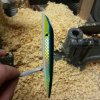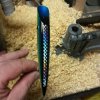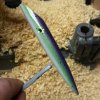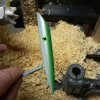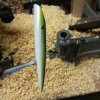You are using an out of date browser. It may not display this or other websites correctly.
You should upgrade or use an alternative browser.
You should upgrade or use an alternative browser.
Tested/Testng New Tackle
- Thread starter TheBigGuy
- Start date
fishin solo
Crew Member
fishin solo
Crew Member
hard to tell in the pic but its also got a bit of silver between the green and white.... and bellies all glowThe Green/White one in particular looks like murder.
The last couple of seasons I have been using the jigs from "Lingcodjigs.com. (attached is a pic). I know its a big debate over ones preference to soaking bait vs jigging, however I can honestly say that these out fished just bait 4 to 1. The Halibut just love them as do the lings. I was amazed at how well they did the first time I dropped them in the water. I take the hook & add a small piece of sdalmon belly to it. Then jig it & its a killer.
** I use the 16 oz jigs**View attachment 31594 View attachment 31595
i tried to order the octopus jigs last year but they sold out. now trying to find a mold. they look wicked
treblig
Well-Known Member
They have arrived in time for the March fishing. AP tackleworks in Victoria has sent testers to challenge chinooks . mixture of herring , sand lance and needle fish trolling spoons.
One of the benefits of being a pro staff /field tester is you get to use allot of different tackle. Help with the development . Take pride that they respect your ability and skills in the sport we all love ....angling . Ap Tackle works have sent me this years trolling package to challenge our local cohos and chinook salmon.
https://www.nationalprostaff.com/r111220-i-love-being-a-field-tester
gil d'Oliveira castingaline.com
One of the benefits of being a pro staff /field tester is you get to use allot of different tackle. Help with the development . Take pride that they respect your ability and skills in the sport we all love ....angling . Ap Tackle works have sent me this years trolling package to challenge our local cohos and chinook salmon.
https://www.nationalprostaff.com/r111220-i-love-being-a-field-tester
gil d'Oliveira castingaline.com
Attachments
Last edited:
grizzly king
Member
Anybody rig their own assist hook jigs. These type of jigs are becoming super popular for jigging in many parts of the world. My son brought me back my first one from Australia about 5 years ago. They are really popular down under and in the far east. Not many jigs sold rigged that way here, and if you can find them they're super pricey. I'm thinking about converting to top rigged hooks on an assist hook rig for a bunch of my old jigs. It should reduce bottom hang ups substantially, and many claim they hook more fish rigged this way.
I was thinking about just using 130lb dacron I already had, but most use kevlar cord. I ordered some 500lb kevlar cord, but it hasn't arrived yet. What hooks and line do you use. Do you add attractors like glow hoochies or synthetics like crystal flash when making your own.
View attachment 31469 View attachment 31470
What size of hook are you using on your 20 oz crippled herring jig?
Thanks
TheBigGuy
Well-Known Member
I would think you would want to use at least a 10/0 or 11/0 bait fishing hook. The bait hook sizes are very misleading. They are nowhere near as big as a 10/0 size octopus hook. I picked up some gamagatsu 9 & 10/0 bait hooks at A&N the other day. The 10/0 is a very beefy hook. They were in 3 packs on sale for $3.49 reduced from $8.49. Not bad at $3.49, but I sure wouldn't pay their regular price. Gamagatsu Hook model 00420.What size of hook are you using on your 20 oz crippled herring jig?
Thanks
wildmanyeah
Crew Member
What type of swivel do you guys like off your main line? Ball bearing swivel or a chain swivel? or what type of setup do you guys use off your main line?
TheBigGuy
Well-Known Member
The way most recommended and sold prerigged use a solid ring to tie your mainline to. The assist hook is attached to the solid ring as well. The split ring attaches to the jig. The advantage to that method is the jig can easily be changed by simply exchanging a new one onto the split ring. That way you can use the same assist rig for many Jigs. You don't have to tie on a new jig to change up lures. Saves some money as well because you don't need to have an assist hook rig for every jig you own.
Mostly guys who use spinning reels on their Jigs use a ball bearing swivel. The spinning reels result in line twist so the ball bearing swivel is necessary if using spinning gear. Most guys here don't use spinning gear, so a swivel isn't required. Solid ring and heavy test split ring is the most recommended method of rigging.
Mostly guys who use spinning reels on their Jigs use a ball bearing swivel. The spinning reels result in line twist so the ball bearing swivel is necessary if using spinning gear. Most guys here don't use spinning gear, so a swivel isn't required. Solid ring and heavy test split ring is the most recommended method of rigging.
TheBigGuy
Well-Known Member
I use 80 lb spectra on my mainline with a short topshot (4-10ft) of mono or flouro in 60-80lb test connected with an Albright Special knot. If you really want a swivel you can attach your mainline to a BB swivel, then attach a 4 ft heavy test shock leader to the swivel. Tie the leader directly to the solid ring.
Last edited:
wildmanyeah
Crew Member
The way most recommended and sold prerigged use a solid ring to tie your mainline to. The assist hook is attached to the solid ring as well. The split ring attaches to the jig. The advantage to that method is the jig can easily be changed by simply exchanging a new one onto the split ring. That way you can use the same assist rig for many Jigs. You don't have to tie on a new jig to change up lures. Saves some money as well because you don't need to have an assist hook rig for every jig you own.
Mostly guys who use spinning reels on their Jigs use a ball bearing swivel. The spinning reels result in line twist so the ball bearing swivel is necessary if using spinning gear. Most guys here don't use spinning gear, so a swivel isn't required. Solid ring and heavy test split ring is the most recommended method of rigging.
lol I guess i should of really specified for salmon fishing, kinda off topic since we were talking about jigging so that's my bad. Only tried jigging once last year while waiting for some crab straps. I could feel the bits all the time but nothing stuck.
TheBigGuy
Well-Known Member
You can use the exact same system for Salmon fishing. Using a top rigged assist hook you will lose way less gear to bottom snags. The only difference is you can use lighter spectra, jigs, and rod.lol I guess i should of really specified for salmon fishing, kinda off topic since we were talking about jigging so that's my bad. Only tried jigging once last year while waiting for some crab straps. I could feel the bits all the time but nothing stuck.
TheBigGuy
Well-Known Member
Well I started modifying some of my old beat up Flashers again. Good way to repurpose my old quality Flashers that have seen better days. Some of my old ones I'd already modified quite drastically and they produced really well.
I thought I would try some different types of modifications this time. I took the heat gun to about a half dozen Flashers I'd stripped of their old tape. I exaggerated the bends at the front and back of the large Flashers and I changed the angle of the front bends on the minis of my Oki and hot spot minis to more closely mimic the style of bends Gibbs uses on the mini Flashers.
I usually mostly use my minis for feeders and coho so the are usually trolled faster than my full size Flashers. The Gibbs bends result in a slightly slower spin than Oki, hot spot, or Luhr Jensen Flashers.
I know some guys have said they take the heat gun and modify their bends. I'm wondering exactly what changes you like to make if you do the rebending thing. Do you add more bend only at the rear, or do you exaggerate the bend on both ends. Does anyone change the position the bend starts on the flasher body, or the angle of the bend crosswise on the flasher. Just curious how some guys change their plastic flasher bends (if it's not top secret).
Way simpler modifying the spin on stainless dodgers and flashers, but I thought I'd experiment to see if I could resurect a few old disused Flashers and turn them into winners. Anyone with any tips on modifying the bends on plastic flasher would be greatly appreciated.
I thought I would try some different types of modifications this time. I took the heat gun to about a half dozen Flashers I'd stripped of their old tape. I exaggerated the bends at the front and back of the large Flashers and I changed the angle of the front bends on the minis of my Oki and hot spot minis to more closely mimic the style of bends Gibbs uses on the mini Flashers.
I usually mostly use my minis for feeders and coho so the are usually trolled faster than my full size Flashers. The Gibbs bends result in a slightly slower spin than Oki, hot spot, or Luhr Jensen Flashers.
I know some guys have said they take the heat gun and modify their bends. I'm wondering exactly what changes you like to make if you do the rebending thing. Do you add more bend only at the rear, or do you exaggerate the bend on both ends. Does anyone change the position the bend starts on the flasher body, or the angle of the bend crosswise on the flasher. Just curious how some guys change their plastic flasher bends (if it's not top secret).
Way simpler modifying the spin on stainless dodgers and flashers, but I thought I'd experiment to see if I could resurect a few old disused Flashers and turn them into winners. Anyone with any tips on modifying the bends on plastic flasher would be greatly appreciated.
TheBigGuy
Well-Known Member
I've found untaped Flashers to work really well at times. The ones that seem to produce the best are Luhr Jensen Flashers. The plastic coloring agent they used on my old Flashers is far more vibrant than any other flasher maker. The old Luhr Jensen Flashers are almost Neon underwater when you remove the tape. The old red and chartreuse Lure Jensen Flashers have worked really well with no tape or with only a small amount of tape reapplied.
Removing the tape can be a pain. The residue it leaves can be a chore to remove. WD40 helps get it off, but so does any household cooking oil. You might want to soak them in oil you used to deep fry fish. Very old Scotty Flashers often have a nasty odor when you remove the tape. I'd rather they smell like my old cooked fish if they are going to have a lingering odor.
You can also use your old fishy smelling used cooking oil to mix in your prawn or halibut chum bait mix. Why not get some added use out of it instead of just discarding it after cooking. If you used it to cook fish more than once it will definitely have absorbed a fair amount of detectable fish odor. I'm all for recycling.
Removing the tape can be a pain. The residue it leaves can be a chore to remove. WD40 helps get it off, but so does any household cooking oil. You might want to soak them in oil you used to deep fry fish. Very old Scotty Flashers often have a nasty odor when you remove the tape. I'd rather they smell like my old cooked fish if they are going to have a lingering odor.
You can also use your old fishy smelling used cooking oil to mix in your prawn or halibut chum bait mix. Why not get some added use out of it instead of just discarding it after cooking. If you used it to cook fish more than once it will definitely have absorbed a fair amount of detectable fish odor. I'm all for recycling.
wildmanyeah
Crew Member
What type of pain do you guys use for your flashers and plugs?
TheBigGuy
Well-Known Member
I'm assuming that was a typo, although the prices on plugs and Flashers is getting a little painful.
Did you mean paint. I know some guys who are real handy custom airbrush their own plugs and they look awesome. Some guys custom paint their own spoons with glow paint. @Dogbreath can give you some recommendations on where to order some glow paints. Flashers are usually taped unless they are tarnished old metal flashers. If you want to redo an old metal flasher sand it down then give it a white base coat then apply some mylar tape to give it back some of its original flash. The only time you might want to paint a plastic flasher is if you don't have a certain colour. I've heard of guys painting plastic ones white or black in the past when those colours were hard to find. Way better to just find the colour you want in plastic, because the paint will eventually chip or peel.
Did you mean paint. I know some guys who are real handy custom airbrush their own plugs and they look awesome. Some guys custom paint their own spoons with glow paint. @Dogbreath can give you some recommendations on where to order some glow paints. Flashers are usually taped unless they are tarnished old metal flashers. If you want to redo an old metal flasher sand it down then give it a white base coat then apply some mylar tape to give it back some of its original flash. The only time you might want to paint a plastic flasher is if you don't have a certain colour. I've heard of guys painting plastic ones white or black in the past when those colours were hard to find. Way better to just find the colour you want in plastic, because the paint will eventually chip or peel.
Last edited:
wildmanyeah
Crew Member
I had a crack in a daisy chain that I fixed with coloured epoxy and was thinking about painting it to match the flasher color. I just wanted to know what type of paint guys use that lasts in the salt.
TheBigGuy
Well-Known Member
Are there any guys out there that know any easy method to strip the fake metallic plating finish off plastic flashers. I'm not talking about mylar tape. I have some old pitted beat up chrome style plastic flashers I'd like to strip the finish off. I started on one Luhr Jensen flasher that was peeling and I really liked the color of the flasher body underneath the fake chrome plating. It had an ivory colored white body that was quite a unique shade, and I'd really like to be able to strip the finish without scratching up the surface. The parts of the flasher where the plating is not damaged is super hard to peel off.
Anyone know how to do this without wrecking the surface of the flasher? Any help would be greatly appreciated.
Anyone know how to do this without wrecking the surface of the flasher? Any help would be greatly appreciated.
Similar threads
- Replies
- 4
- Views
- 891
- Replies
- 20
- Views
- 5K


